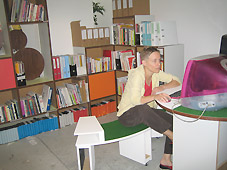 |
 |
|
 |
institution library library
 |
|
 |
LIBRARY
[The archive is open to the public during exhibitions. For access during all
other times please call in advance.]
Under the original name Doku-Stelle, the Shedhalle team in 1996 wanted to create a platform for research, literature, magazines, videos and music which could be used with exhibitions and programmes. The steplike structure simultaneously served as a sitting area for events and as a storage room for materials. Already by then a comfortable situation was designed to invite visitors to listen to music, watch videos or read texts. This platform-element was the prelude to today’s archive.
With the Doku-Stelle growing continuously, the team installed low shelving units to house monitors and recorders. At first, the 8-metre-long unit stood against a wall. As time passed, it became increasingly important to collect and arrange the material more systematically. The range of names used for the wall element – Doku-Stelle / library / archive / book exchange – indicated that clarification had become necessary. Often, the variety of colours and shapes distracted from the exhibitions, and the fixed position of the archive limited the possibilities of the room’s overall design. The project never look back (2001) was aimed at redefining topical critical practices from various perspectives. The archive was restructured for the exhibition. Susanna Perin and Alice Cantaluppi sorted all the materials and arranged them in different categories. Different colours were assigned to these categories in order to systematise the information, publications and videos that had been collected around the Shedhalle productions and projects of the 1990s. The material was complemented by material on the topic ‘Kreis 5’ as the development of the city’s fifth district was seen to exemplify Zurich’s cultural climate in the 1990s. In addition, information on topical projects and activities of the independent scene in Switzerland was included in order to rethink, for example, the meaning of “independent” and “collective”. There was talk of a digitalisation of the archive.
In the following years, the archive was frequently moved around and parts of it, if suitable to the topic, were included in the exhibition designs. The shelves’ aesthetic, most of all the backside, was unsatisfactory and the relocations had left them quite dilapidated. In 2004, Dan Wilkinson was invited to develop ideas for a new lounge and archive situation. His research on Modern zoological architecture at Dudley Zoo in England was the point of departure for the new design, mostly consisting of old material that was recycled. Wilkinson built an archival landscape with a lounge and viewing zone. The necessary rearrangement of archive material offered the chance of including all the videos that had been collected in closets. At the beginning of 2005, Marina Klinker started on this task. She adopted the navigation system of never look back with its colour-codes and topic areas and registered all the videos and some of the other material in a data system especially created for the Shedhalle so that parts of the archive are now accessible by use of a search engine.
Today, the archive’s location is near the entrance. As not all the projects can be systematised within the existing categories, new ones will evolve. The database, too, still awaits its completion.

The archive is comprised of information and materials representative of the work at the Shedhalle. These are books, catalogues, fanzines, records, CDs and numerous videos, as well as collections of flyers and files with text compilations. The videos are works by artists and media groups. The Shedhalle archive is accessible to the public, but the publications, files, videos etc. cannot be borrowed.
Description of the topic areas of the archive
Art Production
Feminist Theory
Gender
Economy/Globalisation
Postcolonialism/Migration
Pop Culture
Urbanism
Media
Technology Criticism
Militarisation and Peace Policies |
|
 |
|
|
|
 |
 |
 |
|